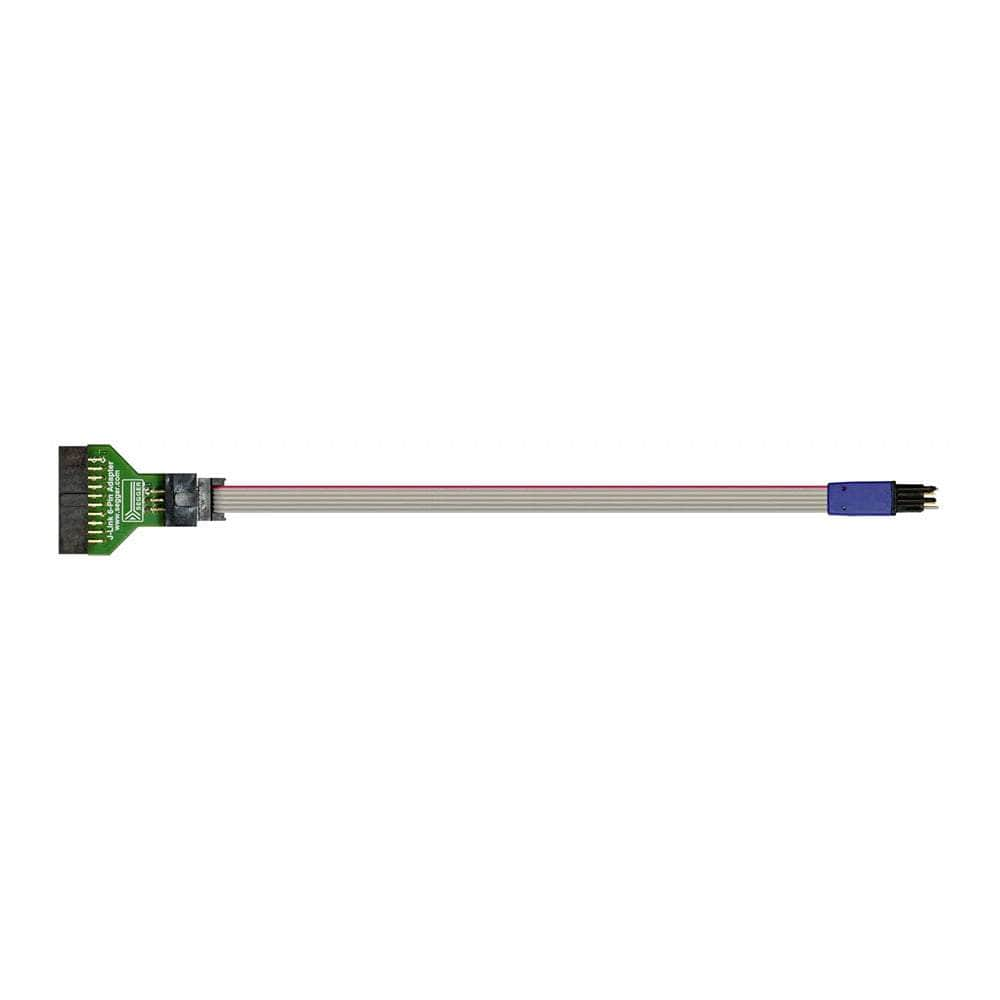

Key Features
Overview
SEGGER 8.06.16 – J-Link 6-Pin Needle Adapter connects a J-Link or SEGGER Flasher to a PCB that omits a mating connector or header. It adapts from the standard 20-pin 0.1″ J-Link/JTAG connector to a compact 6-pin spring-needle pattern intended for SWD-based bring-up and production programming. A tri-pin locating pattern ensures correct orientation, while high-reliability spring pins provide stable contact during test and programming.
This 6-pin variant targets SWD; if full JTAG or target-power pin support is required, consider the SEGGER 10-Pin Needle Adapter (8.06.04). For alternative compact connectors (e.g., Cortex-M 10-pin 0.05″), see the 50-Mil 10-Pin Patch Adapter, and for general J-Link probes visit J-Link BASE Compact.
Engineers choose the needle approach to save PCB area and remove BoM and assembly cost associated with fitted headers, particularly in space-constrained or high-volume designs. The footprint and pinout are widely documented, simplifying PCB library creation and production use.
What to know: Six pins support SWDIO, SWCLK, RESET, SWO (optional), VTref and GND; for JTAG (TMS/TCK/TDI/TDO) use the 10-pin needle adapter.
Downloads
Why Engineers Choose The SEGGER 6-Pin Nadeladapter
Eliminate Headers On Production PCBs
Orientation-Safe, Repeatable Contact
Fits Existing J-Link Workflows
Einführung des 6-poligen Nadeladapters: Eine intelligente Lösung für den PCB-Anschluss
Suchen Sie nach einer nahtlosen Möglichkeit, Ihren J-Link oder Flasher an eine Leiterplatte anzuschließen, die keinen passenden Anschluss oder Programmier-Header hat? Suchen Sie nicht weiter! Der 6-polige Nadeladapter wird Ihren Anforderungen mit seinem innovativen Design und seiner effizienten Funktionalität gerecht.
Intelligentes Design für kinderleichte Verbindung
Der 6-polige Nadeladapter wurde mit einem einzigartigen Muster und drei Positionierungsstiften raffiniert gefertigt. Dies gewährleistet eine kinderleichte Verbindung, sodass der Adapter immer auf die richtige Weise angeschlossen werden kann. Machen Sie sich keine Sorgen mehr über falsche Verbindungen oder zeitaufwändige Fehlersuche!
Kosten- und Platzersparnis
Hersteller, freut euch! Mit dem 6-poligen Nadeladapter können Sie Kosten und wertvollen Platz auf Ihren Leiterplatten sparen. Sie müssen nicht in zusätzliche Steckverbinder investieren, da dieser vielseitige Adapter die Lücke zwischen dem standardmäßigen 20-poligen 0,1-Zoll-Steckverbinder und einem 6-poligen Nadelsteckverbinder schließt und so eine kostengünstige und platzsparende Lösung bietet.
Hinweis: Wenn JTAG-Unterstützung erforderlich ist, verwenden Sie stattdessen den 10-poligen Nadeladapter, da der 6-polige Nadeladapter nicht genügend Pins für JTAG bietet.
| General Information | |
|---|---|
Product Type |
Adapter
|
Part Number (SKU) |
8.06.16
|
Manufacturer |
|
| Physical and Mechanical | |
Weight |
0.02 kg
|
| Other | |
Warranty |
|
HS Code Customs Tariff code
|
|
EAN |
5055383614318
|
Frequently Asked Questions
Have a Question?
-
What if I need a different connector standard later on?
SEGGER provides adapters such as the 50-Mil 10-Pin Patch Adapter and the Target Supply Adapter to cover other scenarios.
-
Any workflow tips for first bring-up?
Follow SEGGER SWD pin guidance (VTref, RESET handling, optional SWO). Verify pull-ups/downs per device vendor before first connection.
-
How does this compare to more expensive fixtures?
Versus custom bed-of-nails fixtures, needle adapters offer much lower NRE and faster setup while still giving repeatable contact for programming.
-
What PCB footprint size should I plan for?
Use SEGGER’s published pad pattern from the datasheet; the footprint is smaller than a fitted header, aiding dense layouts.
-
Will it work with J-Link BASE/PLUS/PRO and SEGGER Flashers?
Yes—designed for J-Link and Flasher families via the 20-pin 0.1″ connector. See also the J-Link BASE Compact.
-
Is this the same as Tag-Connect?
It’s a similar “spring-pin to pad” concept. SEGGER notes its needle pinout is based on Tag-Connect but not identical; the 10-pin variant includes a 5 V supply pin.
-
How does it ensure correct orientation?
A three-pin locating pattern keys the adapter so it only mates one way. This reduces operator error and rework.
-
Does it supply power to the target?
The 6-pin version is intended for SWD signalling. If you need JTAG and the 5 V target-power pin via needle connection, use the 10-pin needle adapter (8.06.04).
-
Which signals are available on the 6-pin footprint?
VTref, SWDIO, SWCLK, RESET, GND and optional SWO for trace/printf. For JTAG signals, use the 10-pin version.
-
What problem does the 6-pin needle adapter solve?
It enables SWD debug/programming on boards without connectors, reducing BoM and PCB area while preserving J-Link workflows.


